- Home >
- Past Institutes >
- Home >
- 2017 Blog
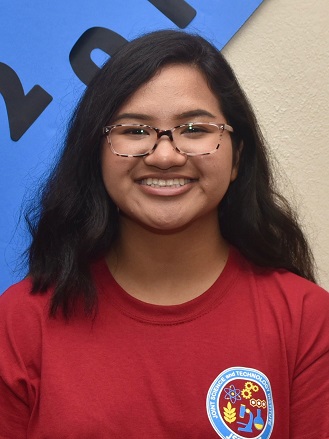 So what is it like to spend part of the summer learning about science, technology, engineering, and math (STEM) with other students and teachers from around the world? Kam Santos-Diaz, a 2014 Joint Science and Technology Institute (JSTI) alumnus, interviewed high school and middle school students during the 2017 JSTI program, which exposes students to scientific research through hands-on projects, enables students to work with real-world scientists, and increase their awareness of career opportunities in related fields.
So what is it like to spend part of the summer learning about science, technology, engineering, and math (STEM) with other students and teachers from around the world? Kam Santos-Diaz, a 2014 Joint Science and Technology Institute (JSTI) alumnus, interviewed high school and middle school students during the 2017 JSTI program, which exposes students to scientific research through hands-on projects, enables students to work with real-world scientists, and increase their awareness of career opportunities in related fields.
Read about their day-to-day activities as they worked with their peers to develop a greater appreciation for STEM:
July 27 | July 28 | July 29 | July 30 | July 31 | August 1 | August 2 | August 3
July 27
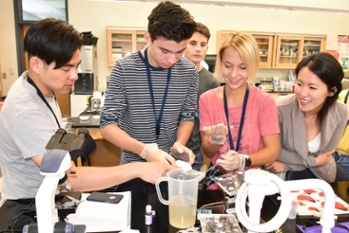 During the Joint Science and Technology Institute (JSTI), it doesn't take long before the students, participant teachers, mentors, alumni, and resident teachers come to understand their place in the STEM program. Each person has a specific role at JSTI for the program to run smoothly, but the most important thing anyone can do at JSTI is learn. Most of the learning happens in the classrooms where students and teachers interact with mentors to gain knowledge important in STEM fields. The 60 high school students attending JSTI are divided into nine groups and each group is tasked with a STEM project such as 3D Design and Printing, Mathematics and Modeling Mania, and Environmental Water Quality. Students find their projects fascinating and are excited to learn more. Student Quinlan McDonnell is in the group titled “Motorized Droplet Actuation System” and explains, “Over the past couple of days we have been experimenting with some of TJ’s (the mentor) technology that he created and patented at Iowa State University.” The technology uses an “XY system with a hydrophobic surface with little hydrophilic marks on it where water droplets stay. The benefit of the system is to do your own biology experiments at a low cost.”
During the Joint Science and Technology Institute (JSTI), it doesn't take long before the students, participant teachers, mentors, alumni, and resident teachers come to understand their place in the STEM program. Each person has a specific role at JSTI for the program to run smoothly, but the most important thing anyone can do at JSTI is learn. Most of the learning happens in the classrooms where students and teachers interact with mentors to gain knowledge important in STEM fields. The 60 high school students attending JSTI are divided into nine groups and each group is tasked with a STEM project such as 3D Design and Printing, Mathematics and Modeling Mania, and Environmental Water Quality. Students find their projects fascinating and are excited to learn more. Student Quinlan McDonnell is in the group titled “Motorized Droplet Actuation System” and explains, “Over the past couple of days we have been experimenting with some of TJ’s (the mentor) technology that he created and patented at Iowa State University.” The technology uses an “XY system with a hydrophobic surface with little hydrophilic marks on it where water droplets stay. The benefit of the system is to do your own biology experiments at a low cost.”
 Students and teachers not only learn during instruction time, but at dinner time, too. On Thursday, July 27, Dr. Eric Moore, the director of Edgewood Chemical and Biological Center (ECBC) spoke to students about his life story, including both failures and successes. Student Evan Bean, also from the Motorized Droplet Actuation System group says, “There is a phrase, ‘Roses are only born through ashes,’ which Dr. Moore exemplified tonight.” Evan Bean summarizes the main points of Dr. Moore’s speech, stating, “If you want to succeed, you must have the three C’s: character, competence, and commitment, and without even one of those, you will not be the best you can be.”
Students and teachers not only learn during instruction time, but at dinner time, too. On Thursday, July 27, Dr. Eric Moore, the director of Edgewood Chemical and Biological Center (ECBC) spoke to students about his life story, including both failures and successes. Student Evan Bean, also from the Motorized Droplet Actuation System group says, “There is a phrase, ‘Roses are only born through ashes,’ which Dr. Moore exemplified tonight.” Evan Bean summarizes the main points of Dr. Moore’s speech, stating, “If you want to succeed, you must have the three C’s: character, competence, and commitment, and without even one of those, you will not be the best you can be.”
Students, teachers, and staff are sure to take the knowledge gained from everyone they come across at JSTI and apply it to their life to ensure a brighter future.
July 28
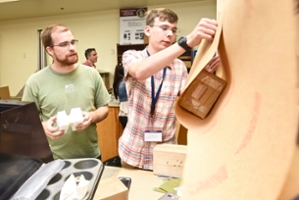 Friday, July 28, was not an average work/class day for this year’s JSTI students. Instead of studying in the classroom, students were dismissed from class to assist the four JSTI alumni with outreach projects for the Boys and Girls Club at Camp Hidden Valley in Maryland. There, the STEM program lead five outreach projects for the campers: Foam Gnomes, Toothbrush Racers, Probots, Little Bits, and STEM Takes Flight. The 60 students were divided evenly into these five groups to teach the campers, ranging from ages six to thirteen, about STEM.
Friday, July 28, was not an average work/class day for this year’s JSTI students. Instead of studying in the classroom, students were dismissed from class to assist the four JSTI alumni with outreach projects for the Boys and Girls Club at Camp Hidden Valley in Maryland. There, the STEM program lead five outreach projects for the campers: Foam Gnomes, Toothbrush Racers, Probots, Little Bits, and STEM Takes Flight. The 60 students were divided evenly into these five groups to teach the campers, ranging from ages six to thirteen, about STEM.
The students described the day as “chaotic yet exciting,” teaching the campers fun applications of STEM allowed the students to renew their love for the field as well. Stephanie Cisneros, a JSTI student currently working on the Rapid Prototyping and Military Packaging project, helped teach the Probot project to the young campers. Stephanie explained that the probots are small cars that can be programmed to “create shapes such as circles, squares, and whatever random lines they wanted to draw by following commands put into the probots.” She continued to say, “showing the campers [STEM] in this way is better than teaching it in classrooms. Being able to see how it actually works is a way for the campers to gain more interest in [STEM].”
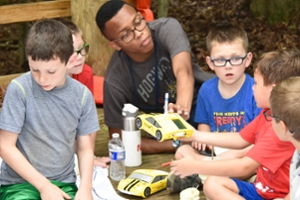 Noah Thrasher, a JSTI student working on the Fused Deposition Modeling Based 3D Printing project, shared Stephanie’s ideas. Noah’s Outreach project was Toothbrush Racers, where students and campers put “motors on the ends of toothbrushes, powered them with batteries, and caused them to act as Hexbugs.” Noah states, “the simplicity of the project helped teach the children and show them that STEM isn’t all nerdy stuff and can be fun.”
Noah Thrasher, a JSTI student working on the Fused Deposition Modeling Based 3D Printing project, shared Stephanie’s ideas. Noah’s Outreach project was Toothbrush Racers, where students and campers put “motors on the ends of toothbrushes, powered them with batteries, and caused them to act as Hexbugs.” Noah states, “the simplicity of the project helped teach the children and show them that STEM isn’t all nerdy stuff and can be fun.”
At Camp Hidden Valley, the campers and the JSTI students learned from one another. The campers learned intriguing ways that STEM can be applied and utilized, while the JSTI students learned how to explain STEM in s fun, creative way. Both the campers and the JSTI students will take what they learned this day and apply it to their future careers, hopefully remembering to always stay excited for STEM!
July 29
 After a long week filled with arduous work, the JSTI 2017 students are relieved to have finally reached the weekend. On Saturday, July 29, the students travelled to Washington D.C., to explore various Smithsonian locations. In the morning, all of the students went to the Smithsonian National Zoo; and in the evening, students split into groups and visited either the Smithsonian National Air and Space Museum or the Smithsonian National Museum of Natural History. No matter the location they went to, everyone agreed that exploring the museums was a wonderful way to have fun and learn at the same time.
After a long week filled with arduous work, the JSTI 2017 students are relieved to have finally reached the weekend. On Saturday, July 29, the students travelled to Washington D.C., to explore various Smithsonian locations. In the morning, all of the students went to the Smithsonian National Zoo; and in the evening, students split into groups and visited either the Smithsonian National Air and Space Museum or the Smithsonian National Museum of Natural History. No matter the location they went to, everyone agreed that exploring the museums was a wonderful way to have fun and learn at the same time.
Jelica Calderon, a student working in the Raspberry Pi to Do Physical Computing project, was very impressed by the Smithsonian National Air and Space Museum. She said, “It was nice to see the simulations the museum had about planets and space and how they were coded to be interactive features.”
 Ngoc Thai, a student in the Fused Deposition Modeling Based 3D Printing group, was equally satisfied by Saturday’s events. Ngoc said, “Going to the museums was fun because we got to hang out with our friends and see the products of STEM, such as airplanes.”
Ngoc Thai, a student in the Fused Deposition Modeling Based 3D Printing group, was equally satisfied by Saturday’s events. Ngoc said, “Going to the museums was fun because we got to hang out with our friends and see the products of STEM, such as airplanes.”
Overall, exploring the Smithsonian museums allowed the JSTI students to see STEM applications brought to life. The students could venture off independently and see exhibits that interested them. After Saturday’s adventure, the JSTI 2017 students were even more excited about STEM than before.
July 30
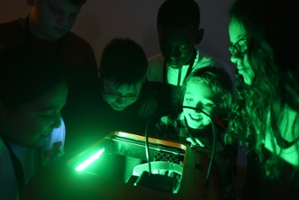 Sunday, July 30, was another relaxing day for the high school students attending JSTI. The students, teachers, and staff went to Aberdeen Swim Club in Maryland to swim and have a cookout, taking full advantage of the beautiful weather this day. Even though the students did not learn anything about STEM, they did learn a lot about each other.
Sunday, July 30, was another relaxing day for the high school students attending JSTI. The students, teachers, and staff went to Aberdeen Swim Club in Maryland to swim and have a cookout, taking full advantage of the beautiful weather this day. Even though the students did not learn anything about STEM, they did learn a lot about each other.
Having a chance to simply hang out with one another allowed the students to strengthen their relationships. Hannah Pak, a student working in the Motorized Droplet Actuation System group, said this was her favorite day so far. She explained, “Going to the pool gave us a chance to meet other participants. During the week, students are usually with the people in their group, but going to the pool allowed them to mingle with students they haven’t met before.”
Even though most of the day was spent relaxing, after dinner the students went straight back to work on their projects. Once back at the hotel, students split up into their groups and worked on their posters for their final presentation. Hollie Arnsdorff, a student also in the Motorized Droplet Actuation System group, appreciated the time given specifically for working on posters. She stated, “Since our group was almost finished, we worked on revising the poster to make sure everything was correct. A resident teacher came to help proofread everything, which was really nice.” For the high school students attending JSTI, Sunday was full of mixed feelings of merriment and anxiousness to finish work.
In another hotel across the street, different feelings were developing. The middle school students attending JSTI arrived. Some of them looked nervous to be away from home, but most of them were excited to begin their new adventure. Soon, the middle school students will learn to appreciate JSTI as much the high school students do.
July 31
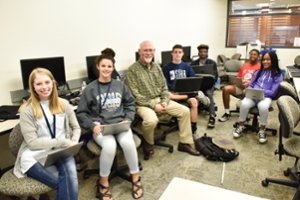 As the second week for the high school JSTI students begins, the students feel pressure to complete their projects in time for their final presentation at the end of the week. In class, mentors waste no time to teach the students new things. Tison Hill, a student in the Cybersecurity and Digital Forensics group, explained the quick pace his group uses. He said, “Just today we learned more about coding and programming to make a website, then we learned how to hack the website just to see how to make it more secure.” The Cybersecurity and Digital Forensics group, along with the other nine groups, are hard at work learning more about their project.
As the second week for the high school JSTI students begins, the students feel pressure to complete their projects in time for their final presentation at the end of the week. In class, mentors waste no time to teach the students new things. Tison Hill, a student in the Cybersecurity and Digital Forensics group, explained the quick pace his group uses. He said, “Just today we learned more about coding and programming to make a website, then we learned how to hack the website just to see how to make it more secure.” The Cybersecurity and Digital Forensics group, along with the other nine groups, are hard at work learning more about their project.
At dinner, a guest speaker visited the HS students. Dr. Terrence E. Johnson, a research associate at the U.S. Army Research Laboratory (ARL), explained his key to success: perseverance. John Emmanuel Garcia, a student also in the Cybersecurity and Digital Forensics group, felt inspired by Dr. Johnson’s speech. John remarked, “Dr. Johnson’s presentation had insightful information. I plan to use his advice in the future to be successful and I hope all the other students follow in his footsteps as well.”
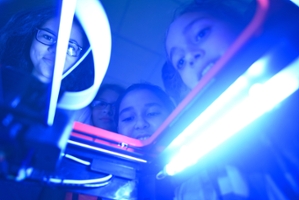 While the high school students were busy finishing their projects, and learning the about the key to success, the middle school students were getting to know their mentors and what their projects are. Kayden Tuffour, a middle school student in the 3D Printing group, explains, “In class today, we were working on creating coins for the military, which sponsors the 3D printing, and competing to see who has the best coin.” In another classroom, the Forensic Chemistry group is also hard at work. Ryuto Thew, a middle school student in that group, enjoyed his first day of class. He said, “In chemistry, we are learning how to take different substances and put them through tests to figure out what the substance is. We are having lots of fun here at JSTI.”
While the high school students were busy finishing their projects, and learning the about the key to success, the middle school students were getting to know their mentors and what their projects are. Kayden Tuffour, a middle school student in the 3D Printing group, explains, “In class today, we were working on creating coins for the military, which sponsors the 3D printing, and competing to see who has the best coin.” In another classroom, the Forensic Chemistry group is also hard at work. Ryuto Thew, a middle school student in that group, enjoyed his first day of class. He said, “In chemistry, we are learning how to take different substances and put them through tests to figure out what the substance is. We are having lots of fun here at JSTI.”
The high school students and the middle school students feel the same excitement and nervousness about JSTI and their final projects. Both groups of students are hard at work to learn valuable information to present on the final day and to remember for the rest of their lives.
August 1
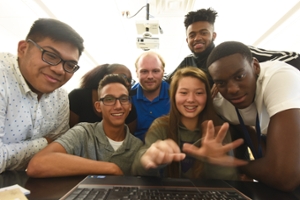
The second week for the high school JSTI students continues and the students begin to feel more confident about the knowledge they gained during class. Dalton Tracy, a student working in the Raspberry Pi group, loves his group and feels he has been learning valuable information. He said, “In the Raspberry Pi group, we use different programs to make completely different things. We made a Google Home, a magic mirror, a photo booth, and a digital picture frame. This is beneficial because looking at different applications, and specially at Raspberry Pi, will help anyone going into fields like computer science.” The Raspberry Pi group has been able to complete many projects in a short amount of time with hard work and perseverance. Dalton and his peers all agree that their group has learned information that will help them in the future.
After working hard in class, the high school students eat dinner and learn more vital information from a guest speaker. Dr. Sweta Batni, an infectious disease epidemiologist, spoke to the high school students about her academic experiences. Hannah Blackford, a high school student also in the Raspberry Pi group, finds Dr. Batni’s advice essential for her future. Hannah explained, “[Dr. Batni] spoke about different career paths and how to just research new paths and keep pushing and working hard to get what you want.” Dr. Batni spoke about her experiences in college, the challenges she faced, and her dedication which led to her success. From Dr. Batni, the students learned to set a goal and to never stop trying to reach that goal.
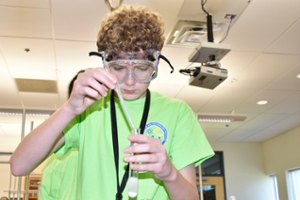 Just like the high school students, the middle school students learned memorable information. The middle school Forensic Chemistry group is working at a fast pace to make the most of their time at JSTI. Student Evan Pope explains the “cool things” his group does in class, saying, “We are doing the burner test where we put chemicals over fire to see colors that they make.” The students in the Forensic Chemistry group are amazed by the different hands-on chemistry experiments that JSTI allows them to do.
Just like the high school students, the middle school students learned memorable information. The middle school Forensic Chemistry group is working at a fast pace to make the most of their time at JSTI. Student Evan Pope explains the “cool things” his group does in class, saying, “We are doing the burner test where we put chemicals over fire to see colors that they make.” The students in the Forensic Chemistry group are amazed by the different hands-on chemistry experiments that JSTI allows them to do.
Once the class day is over, the middle school students are transported to the Iron Birds baseball game at Ripken Stadium to have even more fun. Alex Preston, a student also in the Forensic Chemistry class, enjoyed the baseball game environment. He said, “The baseball game was so cool. I've never went to a minor league baseball game before so it was cool to see the different atmosphere.” The students appreciated the different activities JSTI offers that create memories that last a lifetime.
August 2
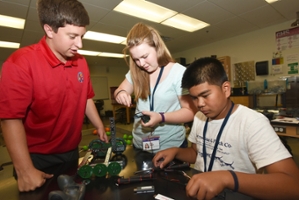
For the JSTI students, Wednesday, August 2, is the last full day in class. The high school students spend their time finishing projects and putting their script together for their final presentation. Grace Durbin, a student in the Robotics group, said her group has been hard at work since the first day of class. She explained, “The robotics group has been building robots and drones, working on the programming for them, and learning how to fly the drones.” Since the robotics group is the largest group, the mentor split the students into two smaller groups: robots and drones. Grace is in the drone subdivision of robotics so her final presentation will focus on just that. She said, “Our final presentation will be about the drones, what we have learned, the things drones are able to do, and the several types of drones.” Grace and the rest of the robotics group learned a remarkable amount of information about both robots and drones in only two weeks.
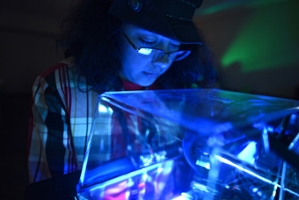 The middle school JSTI students also were hard at work during their last full day of class. Owen Smith, a middle school student in the 3D Printing group, enjoyed his time in class. He said, “My group made little coins with the 3D printers and it was awesome!” For Owen, working with 3D printers was an experience he will remember his whole life. Even though Owen and the 3D Printing group were having fun making coins, they managed to work on their final presentation. Owen explains, “For the skit, my group will have a slideshow about the printers and a story to go along with it.” As time grows closer to the final presentations, Owen grows anxious. He admitted, “I was extremely nervous, but we have been practicing the skit all day so it will hopefully go ok.” Owen believes that most of the middle school JSTI students share the same feelings as he does since they all worked diligently during their week at the summer research program.
The middle school JSTI students also were hard at work during their last full day of class. Owen Smith, a middle school student in the 3D Printing group, enjoyed his time in class. He said, “My group made little coins with the 3D printers and it was awesome!” For Owen, working with 3D printers was an experience he will remember his whole life. Even though Owen and the 3D Printing group were having fun making coins, they managed to work on their final presentation. Owen explains, “For the skit, my group will have a slideshow about the printers and a story to go along with it.” As time grows closer to the final presentations, Owen grows anxious. He admitted, “I was extremely nervous, but we have been practicing the skit all day so it will hopefully go ok.” Owen believes that most of the middle school JSTI students share the same feelings as he does since they all worked diligently during their week at the summer research program.
August 3 - Closing
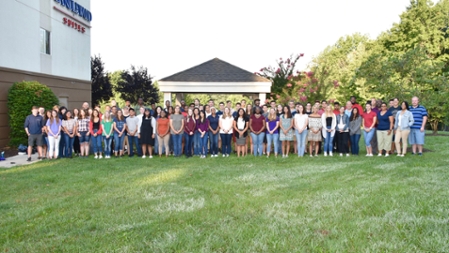
As the last full day of JSTI 2017 comes to an end, the students, teachers, and staff experience mixed emotions. Even though everyone agrees that they cannot wait to sleep in their own bed, no one is truly ready to leave JSTI just yet. In only two weeks, the JSTI 2017 attendees created memories that will last a lifetime.
In honor of JSTI 2017’s finale, students, teachers, and staff share their favorite memory from their two-week adventure:
Tison Hill, high school student (Cybersecurity & Digital Forensics): “My favorite JSTI memory was the escape room because we worked together as a team to figure it out.”
Quinlan McDonnell, high school student (Motorized Droplet Actuation System): “My favorite memory was right when I got here, I met some kids and we started playing cards and that was cool because I felt like I made friends right away.”
James Jordan, high school student (Environmental Water Quality): “My favorite memory with my group was when we were in the ‘candy van’ driving to one of our field trips and we started singing ‘That’s What I Like’ by Bruno Mars.”
Khalil Agee, high school student (Expanded Robotics): “My favorite member was Michael (Robotics mentor) and my favorite memory was when I bent my back so far in the flight simulator at iFly even though it hurt.”
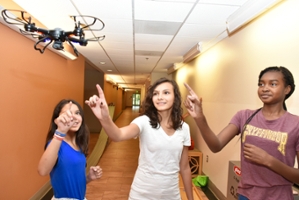 Ryan Galindo, high school student (Fused Deposition Modeling Based 3D Printing): “My favorite memory was when we were trying to get the 3D printers to work and none of them were working.”
Ryan Galindo, high school student (Fused Deposition Modeling Based 3D Printing): “My favorite memory was when we were trying to get the 3D printers to work and none of them were working.”
Andrew Hamilton, high school student (Mathematics and Modeling Mania): “My favorite memory was when we went to the pool with everyone.”
Liam Mackey, high school student (Rapid Prototyping and Military Packaging): “My favorite memory was when I finally opened up my packages at the end of the testing, and I realized that it was a universal success across the board.”
Giulia Mesa, high school student (3D Design and Printing): “My favorite JSTI memory was iFly.”
Dalton Tracy, high school student (Raspberry Pi to Do Physical Computing): “My favorite memory was going swimming and eating barbecue.”
 David Choi, middle school student (Forensic Chemistry): “My favorite memory was when we had a fire experiment and we had to find what the chemical was after testing it in fire.”
David Choi, middle school student (Forensic Chemistry): “My favorite memory was when we had a fire experiment and we had to find what the chemical was after testing it in fire.”
Nathaniel Russo, middle school student (The Technology and Engineering of Drones and Pinewood Derby Cars): “My favorite memory was when we went to the college that had the drones and we got to fly a few drones.”
Elena Avalos, middle school student (The Technology and Engineering of Drones and Pinewood Derby Cars): “My favorite JSTI memory was going to iFly and seeing everyone flying because they were so happy!”
Sydni Garrett, JSTI alumni: “My favorite memory this year would have to be getting to know the kids, and the skydiving place. That was fun. But I also liked [the alumni] being able to go to D.C. I loved every day!!!”
Kam Diaz, JSTI alumni: “My favorite part about JSTI was coming back as an alum instead of as a student. I was able to see JSTI behind the scenes, which made me appreciate the program and all the people who work so hard to make it happen even more. I am also grateful I was allowed to write the JSTI blog because it gave me the chance to talk to the HS students, MS students, and participant teachers individually about JSTI and hear about their experiences.”
Anthony Schmidt, participant teacher (Rapid Prototyping and Military Packaging): “My favorite JSTI memory was either when we were brainstorming and feeding each other ideas or when we went to the ECBC picnic where we got to do the cardboard canoe boat race.”
 Edward Sherlock, participant teacher (Development of a Real-Time Point-of-Care In Vitro Diagnostic Device): “My favorite part about JSTI was actually getting to use the equipment in the lab.”
Edward Sherlock, participant teacher (Development of a Real-Time Point-of-Care In Vitro Diagnostic Device): “My favorite part about JSTI was actually getting to use the equipment in the lab.”
Chris Hart, Ph.D., participant teacher, (In Vitro Blood-Brain and Intestinal Barrier Models for Prediction of Permeability Characteristics in the Drug Discovery Pipeline): “My favorite memory was getting to make new friends and meet all the students and use all the wonderful equipment and techniques I learned while working in the laboratory.”
Terri Reeves, resident teacher: “I love the first and the last day. On day one, airport pickup day, we see these students coming in unsure of what is going to happen. Some are quiet and reserved, and all are watching and waiting. As they are separated into their groups, they begin to grow, learn, and become friends. On the last day, the closing program, we see confident students that are eager to share what they have learned and sad to be leaving each other. It is like we were able to see a flower be planted and nurtured in a group and then grow and bloom. It was amazing!”
Nicole Sudler, lead resident teacher: “My favorite memory was putting out the WhatsApp call for dinner orders. Everyone was working in their groups and we needed a quick turnaround. I had asked for orders to be sent in within the next hour or so and literally everything came back within five minutes! 10 groups, 60 people all in a few minutes. I was so impressed with how well they coordinated their efforts and worked together. I was very impressed with the JSTI 2017 group! It was one of the best we've ever had. This one episode was characteristic of how they handled business throughout the two weeks. As a whole, they were just a really great group of kids and a pleasure to work with. They made all the long hours worth it!”
